Related Research Articles
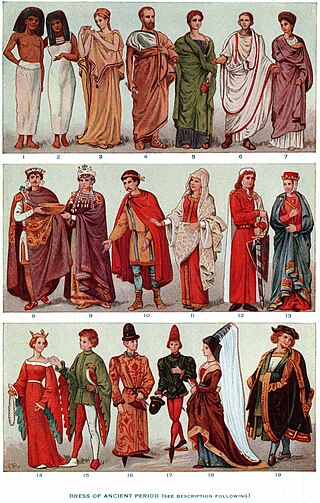
Clothing are items worn on the body. Typically, clothing is made of fabrics or textiles, but over time it has included garments made from animal skin and other thin sheets of materials and natural products found in the environment, put together. The wearing of clothing is mostly restricted to human beings and is a feature of all human societies. The amount and type of clothing worn depends on gender, body type, social factors, and geographic considerations. Garments cover the body, footwear covers the feet, gloves cover the hands, while hats and headgear cover the head. Eyewear and jewelry are not generally considered items of clothing, but play an important role in fashion and clothing as costume.

Textile is an umbrella term that includes various fiber-based materials, including fibers, yarns, filaments, threads, different fabric types, etc. At first, the word "textiles" only referred to woven fabrics. However, weaving is not the only manufacturing method, and many other methods were later developed to form textile structures based on their intended use. Knitting and non-woven are other popular types of fabric manufacturing. In the contemporary world, textiles satisfy the material needs for versatile applications, from simple daily clothing to bulletproof jackets, spacesuits, and doctor's gowns.

A T-shirt, or tee, is a style of fabric shirt named after the T shape of its body and sleeves. Traditionally, it has short sleeves and a round neckline, known as a crew neck, which lacks a collar. T-shirts are generally made of a stretchy, light, and inexpensive fabric and are easy to clean. The T-shirt evolved from undergarments used in the 19th century and, in the mid-20th century, transitioned from undergarment to general-use casual clothing.
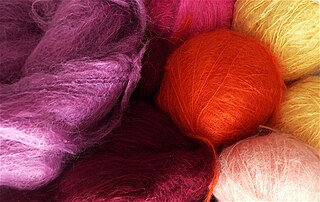
Mohair is a fabric or yarn made from the hair of the Angora goat. Both durable and resilient, mohair is notable for its high luster and sheen, and is often used in fiber blends to add these qualities to a textile. Mohair takes dye exceptionally well. It feels warm in winter as it has excellent insulating properties, while its moisture-wicking properties allow it to remain cool in summer. It is durable, naturally elastic, flame-resistant and crease-resistant. It is considered a luxury fiber, like cashmere, angora, and silk, and can be more expensive than most sheep's wool.
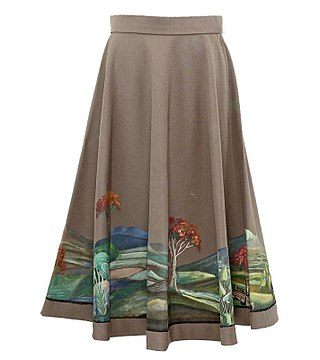
A skirt is the lower part of a dress or a separate outer garment that covers a person from the waist downwards.

Cashmere wool, usually simply known as cashmere, is a fiber obtained from cashmere goats, pashmina goats, and some other breeds of goat. It has been used to make yarn, textiles and clothing for hundreds of years. Cashmere is closely associated with the Kashmir shawl, the word "cashmere" deriving from an anglicisation of Kashmir, when the Kashmir shawl reached Europe in the 19th century. Both the soft undercoat and the guard hairs may be used; the softer hair is reserved for textiles, while the coarse guard hair is used for brushes and other non-apparel purposes.

A blanket is a swath of soft cloth large enough either to cover or to enfold most of the user's body and thick enough to keep the body warm by trapping radiant body heat that otherwise would be lost through convection.

A poncho is an outer garment designed to keep the body warm. A rain poncho is made from a watertight material designed to keep the body dry from the rain. Ponchos have been used by the Native American peoples of the Andes, Valley of Mexico and Patagonia since pre-Hispanic times, from places now under the territory of Mexico, Ecuador, Colombia, Chile, Bolivia, Peru, and Argentina and are now considered typical American garments.

A shawl is a simple item of clothing, loosely worn over the shoulders, upper body and arms, and sometimes also over the head. It is usually a rectangular or square piece of cloth, which is often folded to make a triangle, but can also be triangular in shape. Other shapes include oblong shawls. It is associated with the inhabitants of northern Indian subcontinent—particularly Kashmir and Punjab—and Central Asia, but can be found in many other parts of the world.
Gildan Activewear Inc. is a Canadian manufacturer of branded clothing, including undecorated blank activewear such as t-shirts, sport shirts and fleeces, which are subsequently decorated by screen printing companies with designs and logos. The company also supplies branded and private label athletic, casual, and dress socks to retail companies in the United States including Gold Toe Brands, PowerSox, SilverToe, Auro, All Pro, and the Gildan brand. The company also manufactures and distributes Under Armour and New Balance brand socks. The company has approximately 44,000 employees worldwide, and owns and operates manufacturing facilities in Rio Nance, Honduras and the Caribbean.
Windstopper is a windproof breathable fabric laminate made by W. L. Gore & Associates. One of its most common applications is a lamination with polar fleece, to compensate for fleece's lack of wind resistance.
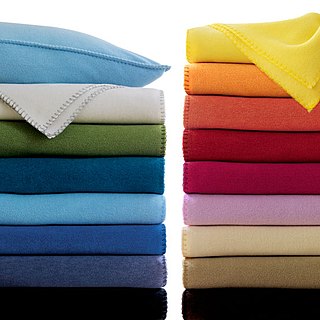
Polar fleece is a soft napped insulating fabric made from polyester.
Malden Mills Industries is the original manufacturer of Polartec polar fleece and manufactures other modern textiles. The company is located in Andover, Massachusetts and has operations in Hudson, New Hampshire.
Patagonia, Inc. is an American retailer of outdoor clothing. It was founded by Yvon Chouinard in 1973 and is based in Ventura, California. Patagonia operates stores in 10+ countries globally, as well as factories in 16 countries.

Alpaca fleece is the natural fiber harvested from an alpaca. There are two different types of alpaca fleece. The most common fleece type comes from a Huacaya. Huacaya fiber grows and looks similar to sheep wool in that the animal looks "fluffy". The second type of alpaca is Suri and makes up less than 10% of the South American alpaca population. Suri fiber is more similar to natural silk and hangs off the body in locks that have a dreadlock appearance. While both fibers can be used in the worsted milling process using light weight yarn or thread, Huacaya fiber can also be used in a woolen process and spun into various weight yarns. It is a soft, durable, luxurious and silky natural fiber.

The thong is a garment generally used as either underwear or in some countries, as a swimsuit. It may also be worn for traditional ceremonies or competitions.

Shweshwe is a printed dyed cotton fabric widely used for traditional Southern African clothing. Originally dyed indigo, the fabric is manufactured in a variety of colours and printing designs characterised by intricate geometric patterns. Due to its popularity, shweshwe has been described as the denim, or tartan, of South Africa.
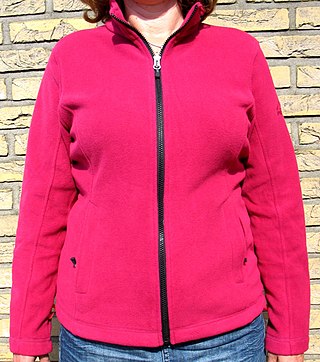
A fleece jacket is a lightweight casual jacket made of a polyester synthetic wool such as polar fleece.
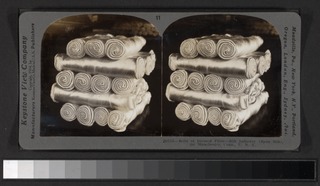
Greige goods are loom state woven fabrics, or unprocessed knitted fabrics. Greige goods undergo many subsequent processes, for instance, dyeing, printing, and finishing, prior to further converting to finished goods such as clothing, or other textile products."Grey fabrics" is another term to refer to unfinished woven or knitted fabrics.
Sherpa is a fabric with a pile on one side and flat on the other side.
References
- 1 2 3 Commerce, United States Bureau of Foreign and Domestic (1916). The Men's Factory-made Clothing Industry: Report on the Cost of Production of Men's Factory-made Clothing in the United States. U.S. Government Printing Office. p. 298.
- ↑ Union, Pan American (1948). Bulletin. p. 403.
- ↑ Tortora, Phyllis G.; Johnson, Ingrid (2013-09-17). The Fairchild Books Dictionary of Textiles. A&C Black. p. 119. ISBN 978-1-60901-535-0.
- ↑ Curtis, Homer S. comp [from old catalog (1916). Dressmakers dictionary . The Library of Congress. [Brooklyn, N.Y., The Guide printing company].
- 1 2 Greenbaum, Hilary; Rubinstein, Dana (2011-11-25). "The Evolution of Fleece, From Scratchy to Snuggie". The New York Times. ISSN 0362-4331 . Retrieved 2021-07-24.